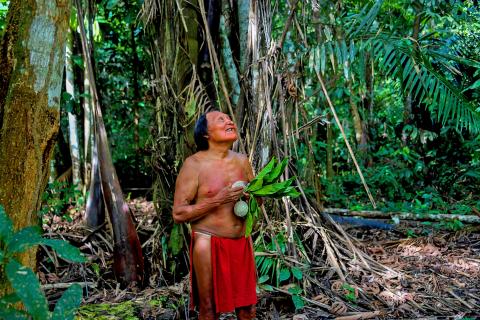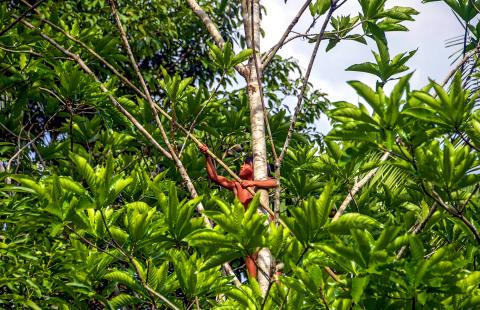When Japarupi Waiapi looks into the dense foliage of the Amazon rainforest, he sees the equivalent of a supermarket, pharmacy, furniture store — and that’s just the beginning.
Food like coconuts, roots and bananas grows plentifully. Animals and fish are readily available for hunting, and the bark of many trees has medicinal uses.
Just in terms of different wood types, “we see thatch for our roofs, we see bows, we see arrow heads,” Japarupi Waiapi, 45, says in the heart of Waiapi tribal land in eastern Brazil.

Photo: AFP
Add to that palm for weaving backpacks, calabash for making bowls, reeds to use as drinking straws, banana leaves as table cloths, animal bones for tools — and all this literally there for the taking.
“We don’t depend on commerce or money,” Japarupi Waiapi says, explaining the tribe’s ancient, self-sufficient way of life, living in isolation from Brazil’s white settlers.
“I tell my son: never put out your hand to the white man. Rely on the forest. Rely on the rivers.”

Photo: AFP
The Waiapi also believe that just as the planet’s biggest rainforest looks after them, their tribe of 1,200 people is uniquely positioned to guard the Amazon, crucial to regulating global climate, for the rest of the world.
For decades, the Waiapi and other Indigenous tribes have been under pressure from miners, ranchers and loggers, who consider the “Indians,” as they are universally known in Brazil, a nuisance at best.
Pressure intensified this August when President Michel Temer declared a vast protected reserve around Waiapi territory, called Renca, open to foreign mining.
Temer had to retreat a month later in the face of withering criticism from environmentalists. But the Waiapi say they will keep watch as long as they live.
“This forest we’re in — we’re the ones who preserve it,” said Tapayona Waiapi, 36, who lives at the edge of tribe’s territory.
HEALING SPIRITS
Hiking into the rainforest, tribesmen warned reporters to keep their eyes peeled for hazards. One spindly, innocuous-looking plant was said to be so poisonous that the tribesmen, wearing only red loincloths, avoided even getting close.
“This is the Amazon — there could be anything,” Jawaruwa Waiapi, 31, said.
But for those who know where to look, the forest is more friend than foe.
Akitu Waiapi, 24, stopped every 20m to point out the benefits of yet another tree. The bark from one helps cure diarrhea, another lowers fever, while a third aids the scarring process.
Many of the trees had already had strips of bark removed.
“There are a lot of medicinal elements in the forest and when people need them they just come and get them,” Akitu Waiapi said.
Invisible, but just as present for the animist Waiapi are the spirits inhabiting trees and rivers and animals. The tribesmen pointed out one of the giants of the forest, the Dinizia excelsa tree, a hardwood which the Waiapi call peyryry. The tree, flanked by massive roots, rose as broad and tall as a castle tower.
“That one has a whole invisible community (of spirits),” Jawaruwa Waiapi said. “There’s everything in there. We can’t see it.”
SUSTAINABLE LOGGING
Ironically, Waiapi agriculture relies on cutting down trees, but they do this sustainably.
Like many other Indigenous peoples around the world, the tribe uses a technique called slash-and-burn or swidden, where a patch of forest is cut down and the dead trees are left to dry before being burned to clear new ground.
The ash helps fertilize the soil which is then planted, mostly with their staple food cassava. Once the soil is exhausted, the Waiapi leave the patch fallow, move on and carve out another.
On a large scale, slash-and-burn can devastate the environment. However, when performed by such a small tribe in a big area, the cleared patches are given time to recover, creating a healthy cycle.
Japarupi Waiapi says his people know how to maintain the balance, moving village as soon as “the land is tired, the river is tired.”
The tribe’s footprint is exceptionally light.
“When you live in the forest, when you hear the music of the animals that live there, it’s different,” Japarupi Waiapi explains during a lunch of smoked monkey meat.
“We understand and can talk to the animals.”
Perhaps seeing the look of surprise on his visitors’ faces, Japarupi Waiapi cups his hands and makes three powerful whistles, each with a slight trill.
Five seconds of silence follow.
Then from somewhere in the dark canopy of virgin forest, a bird calls back. For now, at least, the Waiapi and their beloved Amazon remain in harmony.

The canonical shot of an East Asian city is a night skyline studded with towering apartment and office buildings, bright with neon and plastic signage, a landscape of energy and modernity. Another classic image is the same city seen from above, in which identical apartment towers march across the city, spilling out over nearby geography, like stylized soldiers colonizing new territory in a board game. Densely populated dynamic conurbations of money, technological innovation and convenience, it is hard to see the cities of East Asia as what they truly are: necropolises. Why is this? The East Asian development model, with

June 16 to June 22 The following flyer appeared on the streets of Hsinchu on June 12, 1895: “Taipei has already fallen to the Japanese barbarians, who have brought great misery to our land and people. We heard that the Japanese occupiers will tax our gardens, our houses, our bodies, and even our chickens, dogs, cows and pigs. They wear their hair wild, carve their teeth, tattoo their foreheads, wear strange clothes and speak a strange language. How can we be ruled by such people?” Posted by civilian militia leader Wu Tang-hsing (吳湯興), it was a call to arms to retake

This is a deeply unsettling period in Taiwan. Uncertainties are everywhere while everyone waits for a small army of other shoes to drop on nearly every front. During challenging times, interesting political changes can happen, yet all three major political parties are beset with scandals, strife and self-inflicted wounds. As the ruling party, the Democratic Progressive Party (DPP) is held accountable for not only the challenges to the party, but also the nation. Taiwan is geopolitically and economically under threat. Domestically, the administration is under siege by the opposition-controlled legislature and growing discontent with what opponents characterize as arrogant, autocratic

Desperate dads meet in car parks to exchange packets; exhausted parents slip it into their kids’ drinks; families wait months for prescriptions buy it “off label.” But is it worth the risk? “The first time I gave him a gummy, I thought, ‘Oh my God, have I killed him?’ He just passed out in front of the TV. That never happens.” Jen remembers giving her son, David, six, melatonin to help him sleep. She got them from a friend, a pediatrician who gave them to her own child. “It was sort of hilarious. She had half a tub of gummies,